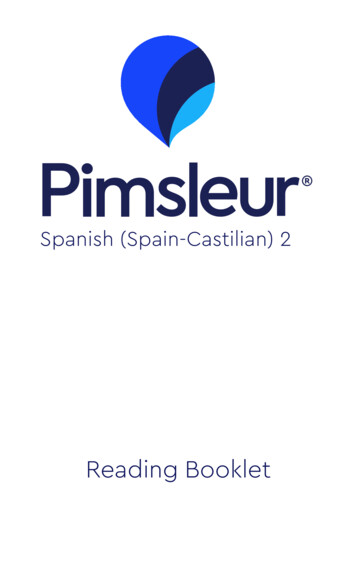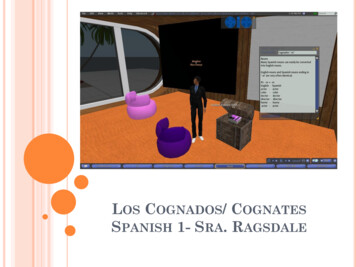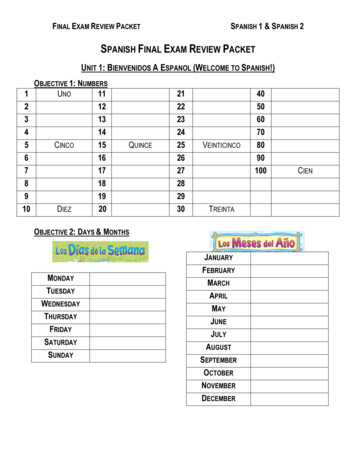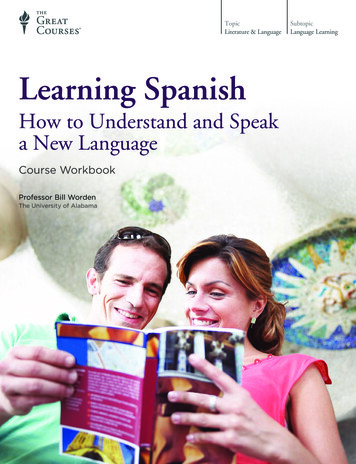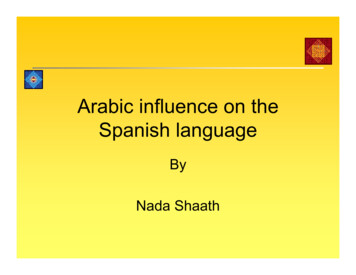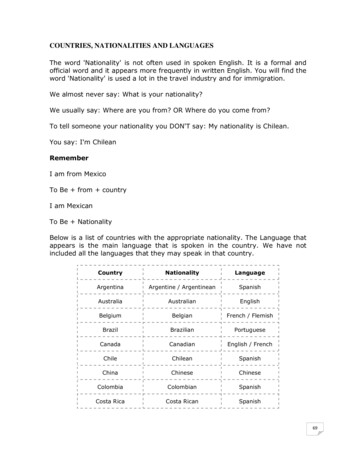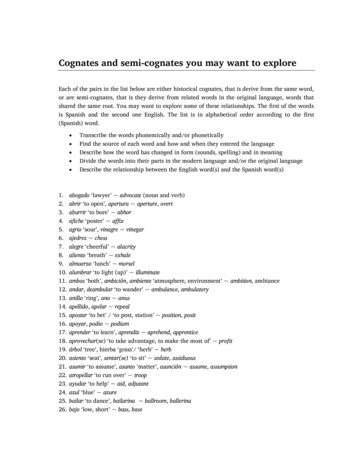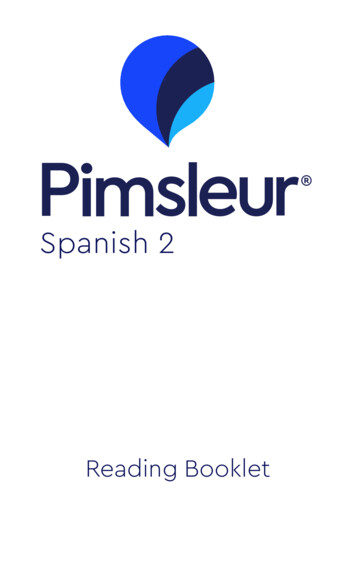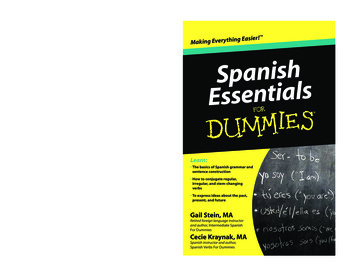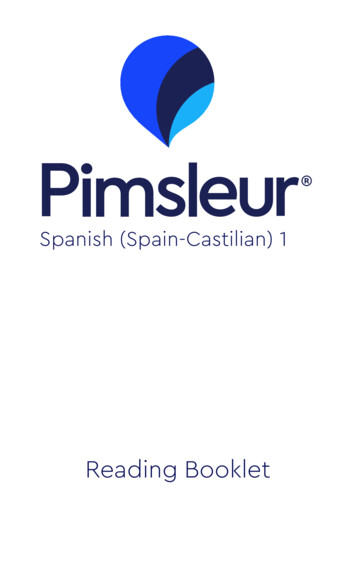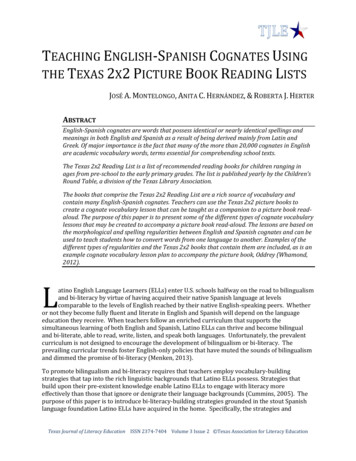
Transcription
TEACHING ENGLISH-SPANISH COGNATES USINGTHE TEXAS 2X2 PICTURE BOOK READING LISTSJOSÉ A. MONTELONGO, ANITA C. HERNÁNDEZ, & ROBERTA J. HERTERABSTRACTEnglish-Spanish cognates are words that possess identical or nearly identical spellings andmeanings in both English and Spanish as a result of being derived mainly from Latin andGreek. Of major importance is the fact that many of the more than 20,000 cognates in Englishare academic vocabulary words, terms essential for comprehending school texts.The Texas 2x2 Reading List is a list of recommended reading books for children ranging inages from pre-school to the early primary grades. The list is published yearly by the Children’sRound Table, a division of the Texas Library Association.The books that comprise the Texas 2x2 Reading List are a rich source of vocabulary andcontain many English-Spanish cognates. Teachers can use the Texas 2x2 picture books tocreate a cognate vocabulary lesson that can be taught as a companion to a picture book readaloud. The purpose of this paper is to present some of the different types of cognate vocabularylessons that may be created to accompany a picture book read-aloud. The lessons are based onthe morphological and spelling regularities between English and Spanish cognates and can beused to teach students how to convert words from one language to another. Examples of thedifferent types of regularities and the Texas 2x2 books that contain them are included, as is anexample cognate vocabulary lesson plan to accompany the picture book, Oddrey (Whamond,2012).Latino English Language Learners (ELLs) enter U.S. schools halfway on the road to bilingualismand bi-literacy by virtue of having acquired their native Spanish language at levelscomparable to the levels of English reached by their native English-speaking peers. Whetheror not they become fully fluent and literate in English and Spanish will depend on the languageeducation they receive. When teachers follow an enriched curriculum that supports thesimultaneous learning of both English and Spanish, Latino ELLs can thrive and become bilingualand bi-literate, able to read, write, listen, and speak both languages. Unfortunately, the prevalentcurriculum is not designed to encourage the development of bilingualism or bi-literacy. Theprevailing curricular trends foster English-only policies that have muted the sounds of bilingualismand dimmed the promise of bi-literacy (Menken, 2013).To promote bilingualism and bi-literacy requires that teachers employ vocabulary-buildingstrategies that tap into the rich linguistic backgrounds that Latino ELLs possess. Strategies thatbuild upon their pre-existent knowledge enable Latino ELLs to engage with literacy moreeffectively than those that ignore or denigrate their language backgrounds (Cummins, 2005). Thepurpose of this paper is to introduce bi-literacy-building strategies grounded in the stout Spanishlanguage foundation Latino ELLs have acquired in the home. Specifically, the strategies andTexas Journal of Literacy Education ISSN 2374-7404 Volume 3 Issue 2 Texas Association for Literacy Education
TEACHING ENGLISH-SPANISH COGNATES USING THE TEXAS 2X2 PICTURE BOOK READING LISTS102activities we put forth feature English-Spanish cognates taught in the context of picture book readalouds in the early primary grades.ENGLISH-SPANISH COGNATESEnglish-Spanish cognates are words that possess identical or nearly identical spellings andmeanings in both languages. The English word, “situation,” and the Spanish word, situación, arecognates, as are “vocabulary,” and vocabulario. Because so many English and Spanish words arederived from Latin, there are more than 20,000 such cognates. In addition to their large numbers,cognates are important because the great majority of them are academic vocabulary terms. Inclassroom texts, many of the boldface words and the terms in glossaries are cognates (Carlo,August, McLaughlin, Snow, Dressler, Lippman, & White, 2008). More than 70% of the 570 words onthe Academic Word List (Coxhead, 2000) are English-Spanish cognates (Hiebert & Lubliner, 2008).Furthermore, the subject terms that comprise the Dewey Decimal System are almost all cognates(Montelongo, 2011).For decades, language educators have advocated for using cognates to teach native Spanishspeakers learning English (e.g., Corson, 1997; Johnston, 1941). Experts suggest teaching cognatesbecause the English and Spanish word equivalents so resemble each other. Empirical evidence, too,has shown that cognate instruction benefits Latino ELLs (Jiménez, 1997). Lubliner and Hiebert(2011) observed that cognates bestow Latino ELLs with “funds of knowledge” that privileges themover English-only peers in the learning of academic language. The learning of cognates can be animportant bridge to academic language that advantages Latino ELLs by enriching their languageproficiency (Hernández, Montelongo, & Herter, in press).TEACHING COGNATES THROUGH PICTURE BOOK READ-ALOUDSPicture books are excellent for building vocabulary (Beck, McKeown, & Kucan, 2002; 2008). Theyare a rich alternative to basal readers, which focus mainly on basic sight words. Picture book readalouds are time-honored vehicles for introducing vocabulary to primary school-aged children (e.g.,Dickinson & Smith, 1994). Picture books are also an especially good source for English-Spanishcognates (Montelongo, Durán, & Hernández, 2013). In that study, picture books written in Englishaveraged approximately 20 cognates per book, a number large enough to sustain an EnglishSpanish cognate vocabulary picture curriculum.When using picture book read-alouds for instruction, it is essential that teachers know whichvocabulary words to teach. Beck, McKeown, and Kucan (2002; 2008) created a three-tiered systemfor selecting the vocabulary words for instruction from picture books. In their system, Tier Onewords are those such as book, house, and banana which require little if any direct instruction as aresult of having been learned through experiences at home or through parental instruction. TierTwo words are “adult-like” words that children know conceptually, but which require directinstruction. For example, the words, fast and rapid have similar meanings. “Fast” is a Tier One wordthat children already know from home. “Rapid” is its Tier Two synonym whose meaning may betaught through direct instruction as part of a read-aloud vocabulary activity. Tier Three words arethose discipline-specific vocabulary words which require direct instruction when their meaning isimportant for comprehension of the text.Texas Journal of Literacy Education Volume 3 Issue 2 Winter 2015
TEACHING ENGLISH-SPANISH COGNATES USING THE TEXAS 2X2 PICTURE BOOK READING LISTS103In their seminal books, Beck, McKeown and Kucan (2002; 2008) provided lists of Tier Two wordsculled from common picture books to illustrate their concept of such words. An analysis of the Beck,et al. (2002; 2008) lists revealed that more than half of the words on both of the lists were EnglishSpanish cognates (Montelongo, et al., in press).ENGLISH-SPANISH COGNATES AND THE TEXAS 2X2 PICTURE BOOK READING LISTSExpert teachers choose quality picture books for their read-alouds (Fisher, Flood, Lapp, & Frey,2004). One source for quality picture books is the Texas 2x2 Reading List, a project of theChildren’s Round Table, a unit of the Texas Library Association. The list has been published yearlysince 2000 in an effort to promote free voluntary reading through high quality picture books,professional development, and engaging programs (Texas Library Association [TLA], 2015). Eachyearly list contains 20 picture books appropriate for age 2 to second grade children.There are many English-Spanish cognates in the Texas 2x2 picture books that may be taughtthrough picture book read-alouds. For the present paper, 113 picture books were analyzed fortheir English-Spanish cognate content. The average number of cognates in the Texas 2x2 bookswas 24.74 cognates per book, more than enough words with which to create effective vocabularylessons.COGNATE MINI-LESSONS THROUGH READ-ALOUDSEnglish-Spanish cognates can be used to teach Latino ELLs about the connections between thelanguage they are learning (English) and the language they already know (Spanish). Throughcarefully planned lessons or mini-lessons, Latino ELLs can learn English, Spanish, and therelationships between them. By studying and learning the similarities and differences betweenEnglish and Spanish terms, especially those related to morphology and spelling, Latino ELLs canlearn to make meanings of unknown words in either language, as well as generate words in eitherlanguage in order to communicate their thoughts and ideas.Many English-Spanish cognates are the Tier Two academic vocabulary words necessary for successin school. The Texas 2x2 picture books are comprised of many Tier Two words, examples of whichmay be seen in Table 1. For instance, the picture book, Creepy Carrots! (Reynolds, 2012), containssuch rich cognate vocabulary terms as: league/liga; passion/pasión; and sinister/siniestro, that canbe taught through a read-aloud.Texas Journal of Literacy Education Volume 3 Issue 2 Winter 2015
TEACHING ENGLISH-SPANISH COGNATES USING THE TEXAS 2X2 PICTURE BOOK READING LISTS104Table 1Tier Two English-Spanish Cognates from the Texas 2x2 Picture BooksPicture BooksTier Two Cognate Vocabulary WordsThe Circus Shipapparently/aparentemente; honest/honesto;possibly/posiblemente; rescue/rescatar; risky/riesgoso;rumor/rumor; sincere/sinceroCreepy Carrotsimagination/imaginación; league/liga; notice/noticia;passion/pasión; regular/regular; ridiculous/ridículo;sinister/siniestro; victory/victoriaIguanas in the Snow and Other WinterPoemsabundant/abundante; adornment/adorno; anxious/ancioso;aroma/aroma; ode/oda; savor/saborear; spiral/espiral;survive/sobrevivir;In the Wildaffection/afecto; bandit/bandido; delicate/delicado;distant/distante; ordered/ordenado; ordinary/ordinario;pave/pavimentar; silently/silenciosamente;Little Dog Poemsbreeze/brisa; enormous/enorme; lesson/lección;mystery/misterio; obedience/obediencia; sentinel/centinela;supervise/supervisar; triumph/triunfoLMNO Peasacrobat/acróbata; explorer/explorador; inventor/inventor;pose/pose; unique/único; volunteer/voluntario; voter/votante;yogi/yoguiOddreyappear/aparecer; appreciate/apreciar; decide/decidir;improvise/improvisar; save/salvar; situation/situación;supervise/supervisor; suppose/suponerPocketful of Posiescompare/comparar; dame/dama; fine/fino; mend/remendar;rare/raro; reason/razón; surely/seguramente; tart/tarta;trot/trotarThe Three Ninja Pigsbalance/balancear; basic/básico; crescent/cresciente;degree/grado; persist/persistir; progress/progreso;retreat/retirar; suffer/sufrir; technique/técnica;The Ugly Ducklingadmit/admitir; autumn/otoño; confusión/confusión;cruelty/crueldad; disgrace/desgracia; exhausted/exhausto;harmony/armonía; pure/puro;A Visitor for Bearattentive/atento; exclaim/exclamar; firmly/firmemente;impressive/impresionante; insufferable/insufrible; intolerable/intolerable; rigid/rígido;English words frequently share the same morphology as Spanish words because of these languages’roots in Latin and Greek. This makes it possible for teachers to craft mini-lessons to accompanypicture books that teach specific Latin and Greek root words for making transparent theTexas Journal of Literacy Education Volume 3 Issue 2 Winter 2015
TEACHING ENGLISH-SPANISH COGNATES USING THE TEXAS 2X2 PICTURE BOOK READING LISTS105relationships between English words and their Spanish cognates. Examples of shared root wordsmay be seen in Table 2. In the picture book, I Stink! (McMullan, 2002), the root word, -ject- (tothrow), carries the same meaning in the English word, eject, as in its Spanish cognate, eyectar. Thismorphological generalization or rule may be extended to other such examples through ruleinduction mini-lessons using such cognate pairs as: inject/inyectar and project/proyectar. Anchorcharts of these generalizations or rules may be posted on classroom walls around the room tofurther reinforce the learning of the generalizations (Hernández, Montelongo, Delgado, Holguín &Carmona, 2014).Table 2Examples of Latin and Greek Root Words in the Texas 2x2 Award Picture BooksPicture BooksRootMeaning EnglishSpanishCognateCognateIguanas in the Snow and Other Winter Poems-ling-languagebilingualbilingüeDiary of a Worm-anni-yearanniversaryaniversarioLMNO Peas-astro-starastronautastronautaI Dare You Not to Yawn-uni-oneuniverseuniversoDigger, Dozer, Dumper-spect-seeinspectinspeccionarThe Perfect u-equalequaligualZ Is for Moose-phon-soundxylophonexilófonoEdwin Speaks Up-sect-cutsectionsecciónThe Three Ninja Pigs-gress-goprogressprogresoSuper Hair-O and the Barber of Doom-photo-lightphotonfotónDuck on a Bike-ped-footpedalpedalearI Stink!-ject-throwejecteyectarStep Gently Out-chrys-goldchrysaliscrisálidaThe Astonishing Secret of Awesome Man-therm-heatthermometertermómetro-clar-make rio-rid-laughridiculousridículoDog in BootsA Balloon for IsabelFox Makes FriendsHere Comes Mother GooseCreepy Carrots!Texas Journal of Literacy Education Volume 3 Issue 2 Winter 2015
TEACHING ENGLISH-SPANISH COGNATES USING THE TEXAS 2X2 PICTURE BOOK READING LISTS106The cognates in the Texas 2x2 books can also be excellent springboards for teaching morphologicalgeneralizations about suffixes that govern the conversion of English words to Spanish words (andvice-versa). Some of the suffix rules in Texas 2x2 books are listed in Table 3. For example, Englishcognate adverbs that end in the suffix, –ly, can frequently be converted into the Spanish cognateadverbs ending in the suffix, –mente. This generalization may be seen in the English-Spanishcognate pair, sincerely/sinceramente, from In the Wild (Elliott, 2013).Table 3Examples of Cognate Morphological Regularities from Texas 2x2 Award Books.Picture BookMorphological Regularity Examples from BookShark vs. Train-ant -antedistant distanteThe Neighborhood Mother Goose-ary -ariocontrary contrarioCome On, Rain!-ect ectoinsect insectoHunter's Best Friend at School-ed -adoruined arruinado-ence -anciaobedience obedienciaThe Astonishing Secret of Awesome Man-gy -gíaenergia energíaDog in Boots-ic -icofantastic fantásticoLittle Dog PoemsMe Jane-ical -icomagical mágicoA Visitor for Bear-id -idorigid rígidoBeautiful Blackbird-ist -istaartist artistaThe Astonishing Secret of Awesome Man-ity -idadidentity identidad-ive ivomassive masivo-ly -mentesincerely sinceramenteDigger, Dozer, DumperIn the WildPunk Farm-ment -mentocement cementoThe Ugly Duckling-ous -osoglorious gloriosoCreepy Carrots!-sion -siónpassion pasiónBats at the Beach-tion -ciónlotion lociónIn addition to morphological generalizations, there are also spelling generalizations that can belearned for converting English words to Spanish words and the converse. These may be seen inTable 4. For example, many English words containing double consonants become Spanish wordswith a single consonant as in the cognate pair, suffer/sufrir, in The Three Ninja Pigs (Schwartz,2012). Similarly, the /ch/ in English words is frequently converted to /k/ as in the cognate pair,champion/campeón, from the book, I Know a Wee Piggy (Norman, 2012).Texas Journal of Literacy Education Volume 3 Issue 2 Winter 2015
TEACHING ENGLISH-SPANISH COGNATES USING THE TEXAS 2X2 PICTURE BOOK READING LISTS107Table 4Examples of Cognate Spelling Regularities from the Texas 2x2 BooksPicture BookSpelling Regularity Examples from BookRound Is A Tortilla: A Book of Shapescc caccompany acompañarPunk Farmdd dmiddle medioThe Three Ninja Pigsff fsuffer sufrirDuck & Goosegg gsuggest sugerirStep Gently Outll lpollen polenmm mmammal mamíferoDiary of a Wormnn nanniversary aniversarioOddreypp psuppose suponerThe Three Ninja Pigsss sprogress progresoThe Black Rabbittt tattack atacarI Know a Wee Piggych kchampion campeónActual SizeLittle Dog Poemsph ftriumph triunfoThe Circus Shipth tpython pitónGracias Thankssc- esc-scene escenarioDog in Bootssk- esq-ski esquíOne Dark Nightsp- esp-spy espiarMy Blue Is Happyst- est-statue estatuaThere are also word-initial generalizations or rules that can be used to convert an English word intoits Spanish cognate, and Spanish words into English ones. Teachers of Latino ELLs often remarkabout the tendency the students have for adding an extra syllable at the beginning of English wordshaving word-initial digraphs. A frequent example of this is found in the pronunciation of the word,“stop,” which is mispronounced as “estop.” Examples which follow that particular word-initial ruleare given in Table 4. These are the English words: ski, spy, and statue, which are the cognates ofSpanish words possessing an extra syllable: esquí, espiar and estatua.Anchor charts containing this and other word-initial, word-ending, and spelling generalizationsmay be used to teach and reinforce the mini-lessons. Through such useful mini-lessons, LatinoELLs can learn to convert unknown or problematic words into English or Spanish words thatlogically fit the context, all the while becoming better spellers. The converse is also true. LatinoELLs can generate words or spellings that approximate English or Spanish words they have notencountered by using their knowledge of these generalizations.Texas Journal of Literacy Education Volume 3 Issue 2 Winter 2015
TEACHING ENGLISH-SPANISH COGNATES USING THE TEXAS 2X2 PICTURE BOOK READING LISTS108A SAMPLE MINI-LESSON: ODDREY (WHAMOND, 2012)Montelongo, Hernández, and Herter (in preparation) have presented a format for creating cognatemini-lessons to accompany picture book read-alouds. The format includes the storyline as well asthe content and language objectives of the mini-lesson, the major theme(s) of the picture book, anda step-by-step section for delivering the mini-lesson. A complete example of such a mini-lesson forthe Texas 2x2 Award picture book, Oddrey (Whamond, 2012) is presented in Figure 1.Picture Book – Oddrey (Whamond, 2012)Reading Level – 2.3 (AR Book FinderTM)Audience: Primary Students, grades 1-3.Storyline: Oddrey is different from her classmates. Her creativity and individuality are oftenfrowned upon by her teacher and peers and she often feels alone. For the school play,Oddrey is given one of the lesser roles, much to her dismay. When things begin to gowrong, however, Oddrey uses her creative mind to save the day.Main Idea(s): Persons have to be true to themselves, no matter what the situation.Strive to make the best of unfavorable situations.Content Objective: To introduce young learners to being true to themselves and to make thebest of unfavorable situations.Language Objective (1): To teach the cognate vocabulary words:appear/aparecer, appreciate/apreciar, decide/decidir,improvise/improvisar, situation/situación, style/estilo,suppose/suponer, and unique/único.Language Objective (2): To teach the suffix generalization, English /-ly/ Spanish /-mente/apparently/aparentemente, differently/diferentemente,really/realmente, and uniquely/únicamente,Language Objective (3): To teach the spelling objective that double consonants in Englishwords often become single consonants in Spanish:appear/aparecer, appreciate/apreciar, class/clase,different/diferente, and suppose/suponer.Figure 1. Plan for Oddrey (Whamond, 2012).Oddrey tells the story of a young schoolgirl who is different from everyone else in her classroom.According to her father, “she dances to the beat of a different drum.” In the story, Oddrey is given aminor role in the school play. Although she is disappointed by this, she resolves to do the best shecan to make the play a success. And when everything in the play starts to go wrong, Oddrey stepsup and saves the day, using creative ways of making sure that the play is a success.Among the content objectives for the read-aloud of Oddrey are those that deal with the lessons to belearned. Therefore, one objective of the lesson is to teach schoolchildren to be true to themselves.Another lesson to be learned is that children and persons should try their best to make difficultsituations better.Texas Journal of Literacy Education Volume 3 Issue 2 Winter 2015
TEACHING ENGLISH-SPANISH COGNATES USING THE TEXAS 2X2 PICTURE BOOK READING LISTS109In the sample lesson plan, there are three language objectives that may accompany the read-aloud,all of which feature English-Spanish cognates. The first language objective consists of teachingeight cognate English vocabulary words along with their Spanish cognates. The eight Englishcognate words are Tier Two words that require direct instruction: appear/aparecer,appreciate/apreciar, decide/decidir, improvise/improvisar, situation/situación, style/estilo,suppose/suponer, and unique/único. Montelongo, Hernández, and Herter (in preparation) suggestthat the cognate pairs be presented and their meanings be front-loaded prior to the read-aloud andreviewed in context after the read-aloud and discussion of the story’s theme. Front-loading thevocabulary establishes and activates connections between the English words and their meanings inSpanish. Every time the English words are heard in the context of the read-aloud text, theassociations between the English words and their meanings in Spanish are strengthened. After theread-aloud, additional discussion, elaboration, or pictorial depiction of the English word’s meaningrelative to its Spanish cognate further strengthens the association. A word wall including bothEnglish and Spanish words may be hung in the classroom to strengthen the association (Hernández,Montelongo, Delgado, Holguín & Carmona, 2014).One of the cognate vocabulary words, uniquely/únicamente, affords the possibility to teach LatinoELLs a suffix generalization: the English adverbial ending /-ly/ is frequently the equivalent of theSpanish ending /-mente/. To extend the lesson, other examples from Oddrey such as:apparently/aparentemente, differently/diferentemente, and really/realmente, can be included tostrengthen the learning of the rule. Anchor charts comprised of exemplars of the suffixgeneralization may also be displayed in the classroom to continually remind students of the rule.A third language objective is to teach a spelling rule for transforming English words into Spanishand vice-versa. The cognate word pair appear/aparecer, provides a springboard for teaching therule that English words having a double consonant often become Spanish cognate words with asingle consonant. The spelling mini-lesson may include other cognate words from the book whichexemplify the rule: appreciate/apreciar, class/clase, different/differently, and suppose/suponer. Aswith the suffix generalization, an anchor chart of the spelling rule may also be posted in theclassroom.A step-by-step plan for ordering the read-aloud and the mini-lessons is presented in Figure 2. Assuggested in Figure 2, a teacher may begin the set of activities by introducing the eight cognatevocabulary words to establish the connections in memory between the English word and itsSpanish meaning. This is best done by prompting the students with the English word and havingthem guess at its Spanish cognate equivalent. After listening to the students’ response(s), theteacher provides the Spanish cognate. This sequence is repeated until all of the English-Spanishcognate associations have been introduced.Following the frontloading of the vocabulary words, the teacher establishes grounding for thepicture book’s theme(s). In the case of Oddrey, a teacher might begin to discuss the issue offollowing others blindly by posing a question such as, “Do you do what others around you do so thatyou do not feel different? Another one of the themes in Oddrey is that persons should do all theycan to make a bad situation better. Teachers may ask their students to recall cases of whensomeone did all they could to fix a situation that was not going well.Texas Journal of Literacy Education Volume 3 Issue 2 Winter 2015
TEACHING ENGLISH-SPANISH COGNATES USING THE TEXAS 2X2 PICTURE BOOK READING LISTS110 Frontload the English-Spanish cognate pairs prior to the read-aloud.o Present the eight English words and have the students anticipate its Spanishequivalent. Discuss the concept of a cognate and the meaning of the two words. Provide content background for the read-aloud.o A teacher might begin with a discussion of “doing as everyone else does.” Ateacher might ask, “Do you follow everyone’s example?” or, “Do you try to makethe best of every situation?” Read the Texas 2x2 picture book, Oddrey by Dave Whamond. Discuss the storyline and theme of Oddrey.o The teacher and the students can discuss what happened in the story and howOddrey saved the play. Review cognate vocabulary in context.o Following the discussion of the picture book’s theme, the teacher should reviewthe cognate vocabulary words in context by re-reading the occurrences of thewords in text and discussing and elaborating the meanings of the words. Teach the generalization, English adverb ending /-ly/ Spanish ending /-mente/.o A teacher can present an anchor chart containing examples of the rule and leadsthe students to induce the rule by asking about the differences between theEnglish and Spanish words. The students should be able to guess the rule:English adverbs ending in /-ly/ become Spanish adverbs ending in /-mente/. Teach spelling generalization, double consonants in English words often becomesingle consonants in Spanish words.o A teacher can present an anchor chart that contains examples of English wordspossessing double consonants and their Spanish equivalents that contain singleconsonants. Following the examination of the list, students should beencouraged to generate examples of their own.Figure 2. Procedural plan for Oddrey (Whamond, 2012)Once the book has been read, the teacher begins with a discussion of the story and its theme. Afterthe theme has been discussed, the teacher proceeds to review the eight cognate vocabulary wordsusing the context provided by the story. This can be accomplished by either re-reading theoccurrences of the vocabulary words in text, by presenting the occurrences visually either on achart tablet or by displaying the occurrences on wall using a projector. Flashcards can also be usedto further strengthen the association between the English and Spanish cognates.The example lesson plans (Figure 1 & 2) invite teachers to craft and teach a cognate mini-lessonabout the English adverbial suffix ending, /-ly/ and the equivalent /-mente/ suffix in Spanish. Oneway of presenting this lesson is through anchor charts which devote one column to the Englishwords: “apparently,” “differently,” “really,” and “uniquely” and a second column to their respectiveSpanish cognate mates: aparentemente, diferentemente, realmente, and únicamente. An anchorchart should then be displayed on a classroom wall to remind students of what they learned.For the final mini-lesson in Figure 2, a teacher can create a spelling lesson in which the students aretaught that English words possessing a double consonant often become Spanish words having onlyone. Teachers can use anchor charts to present spelling rules such as the one provided in Figure 2.One way to do this, is to list the column of English words: “appear,” “appreciate,” “class,” “different,”and “suppose” on one side of the chart, side-by-side with the list of the respective Spanish cognates:aparecer, apreciar, clase, diferente, and suponer, on the other. For this example, students can readilyTexas Journal of Literacy Education Volume 3 Issue 2 Winter 2015
TEACHING ENGLISH-SPANISH COGNATES USING THE TEXAS 2X2 PICTURE BOOK READING LISTS111see that the double consonants in the English words become single consonants in the Spanishcognates.CONCLUDING REMARKSOur experiences in classrooms suggest that Latino ELLs feel empowered by their learning aboutEnglish-Spanish cognates. Once they learn the concept of the cognate, Latino ELLs begin to noticethem not only in their reading materials but also in their home environments. They are curiousabout cognates and about the relationships between the two languages. Students constantly askquestions about whether or not a word is a cognate and often point out the cognates they observeduring lessons. The authors have observed fourth-grade Latino ELL schoolchildren remaining intheir classrooms to search for cognates in textbooks and library books instead of going out torecess, further demonstrating that teaching Latino ELLs is educational and enjoyable, too(Hernández, Montelongo, Minjarez, & Oblack, 2011).Teaching Latino ELLs about cognates puts them on the paths to bilingualism and bi-literacy.Teachers who feel that bilingualism and bi-literacy are important educational objectives for LatinoELLs can do their part toward the furtherance of this goal by including cognate mini-lessons as partof their picture book read-alouds. The Texas 2x2 children’s books are especially excellent sourcesfor introducing cognate vocabulary.REFERENCESBeck, I., McKeown, M., & Kucan, I. (2002). Bringing words tolife. New York City, NY:The Guilford Press.Beck, I., McKeown, M., & Kucan, I. (2008). Creating robustvocabulary. New York City, NY: The Guilford Press.Carlo, M., August, D., McLaughlin, B., Snow, C., Dressler, C.,Lippman, D., & White, C. E. (2008). Closing the gap:Addressing the vocabulary needs of EnglishLanguage Learners in bilingual and mainstreamclassrooms. Journal of Education, 189(1/2), 57-76.Corson, D. (1997). The learning and use of academic Englishwords. Language Learning, 47(4), 671-718.Coxhead, A. (2000). A new academic word list. TESOLQuarterly, 34(2), 213-238.Cummins, J. (2005). A proposal for action: Strategies forrecognizing he
Spanish cognate vocabulary picture curriculum. When using picture book read-alouds for instruction, it is essential that teachers know which vocabulary words to teach. Beck, McKeown, and Kucan (2002; 2008) created a three-tiered system for selecting the vocabulary words for
